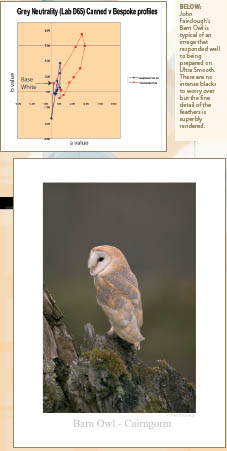articles/Paper/mattphotoblack-page2
Paper Chase - Matt Black or Photo Black - Which is Best - part 2 of 1 2 3 4
by Mike McNamee Published 01/01/2005

The VerdictPaper Chase
For each media a bespoke profile was made using an X-Rite DTP 41 spectro and Monaco profiler. For Permajet Portrait, Smooth Fine Art media setting was used; for PremierArt Canvas,Watercolour Radiant White was used (as recommended). A resolution of 1440dpi was used throughout, with bi-directional printing turned off, Black Point Compensation turned on and a rendering intent of Perceptual. Approximately 1hr was allowed for dry down, testing showed this to be more than adequate. The standard Colour Audit test target was used for both visual and spectrographic analysis. Paper Chase
In order to avoid lapsing into subjective arm waving we compared hard data between the two ink sets.However the question still has to be posed "can you see the difference in real prints?" We viewed in natural daylight (North facing sky overcast conditions), D65 graphics illumination, tungsten light and some rather tricky low energy bulb light.The Matte Black produced just detectably darker blacks and deep browns and this effect could be seen in side-by-side comparisons.Other tones were much more difficult to detect differences in.
The verdict? If you need to keep touch with longevity databases stay with Matte Black on art papers. Avoid Matte Black on gloss and lustre finishes. For most commercial work you will find the Photo Black is adequate on both types of surface.
UPDATE FOR LIFERS
We mentioned the magazine PCPro in our editorial this issue in regard to XP service packs. In the meantime they have issued another magazine which is of great interest to readers of Professional Imagemaker.The February 2005 (Issue 124) is compulsory reading for all photographers and artist who sell their images. One can only look in envy at the resource that PCPro can throw at a topic - they put one guy on testing printers and papers for several months! Oh the things you can do when your certified circulation is in excess of 100,000 copies! Importantly they tested the printers for all the usual stuff like print speed, ink usage and cost, but then put a sting in the tail by hanging prints in the window for months on end.The data make uncomfortable reading for most manufacturers. Indeed the only one to come through unscathed was Epson and their R800/Ultrachrome ink combination (there - we told you it was good last issue!). Even Epson got a bit of flack on ink costs but HP came out worst in the ink cost derby as the 5th most expensive liquid in the world at £2.71 per ml - still less than Mrs Editor's Chanel No 5 though! On the plus side HP were commended on their fade resistance.

Combining the PCPro data and the Wilhelm Research Imaging data does not change the basic rules of play, which remain as follows
1. Pigments are more fade resistant than dyes
2. Paper quality counts for a lot
3. Mismatch the paper and ink chemistry and you are in trouble
4. Optical brightening agents should be avoided
5. Cheap, dodgy compatible ink cartridges are what they are, cheap and dodgy!
On a much more positive note, the Wilhelm imaging data for Ultrachrome inks has reached 100years plus for a number of inkjet combinations, especially if the under glass rule is obeyed. However even if exposed directly to the atmosphere (i.e. bare frame no glass) Epson canvas bagged 120 years if coated with PremierArt Spray (not the new canvas tested here, the older one). You should take care to assess the life projections on prints you make and sell, some technologies only project 4 year lives even on the rather gentle Wilhelm testing regime. Silver halide users should not be complacent either; the better inkjets are outlasting them by a factor of more than two. Some of the biggest variations occur within the emerging 6x4 desk top printers such as the Epson PictureMate. This has projected lives of 104 years but some of its competitors can only manage 4 years!
Where does the Matte Black v Photo Black issue lie in all this? Well much of the data is for art papers, which we assume, are using Matte.There are also data on black and white prints using the full colour ink set.These push some of the fade lives out to beyond 200 years and although the ink set is not specified it seems reasonable to assume that an Epson 4000 data set would use MK for art paper and PK for gloss and lustre finishes.This being the case, the matte ink seems to be outliving the photo ink but you cannot separate out other influences such as the different coating and polymer technologies in use. If you do a simplistic averaging of the data the gloss and lustre's get to 103 years and the art surfaces to 155 years.
Visit www.wilhelm-research.com for up to date analysis.
Please Note:
There is more than one page for this Article.
You are currently on page 2
- Paper Chase - Matt Black or Photo Black - Which is Best page 1
- Paper Chase - Matt Black or Photo Black - Which is Best page 2
- Paper Chase - Matt Black or Photo Black - Which is Best page 3
- Paper Chase - Matt Black or Photo Black - Which is Best page 4
1st Published 01/01/2005
last update 09/12/2022 14:56:33
More Paper Articles
There are 22 days to get ready for The Society of Photographers Convention and Trade Show at The Novotel London West, Hammersmith ...
which starts on Wednesday 14th January 2026





